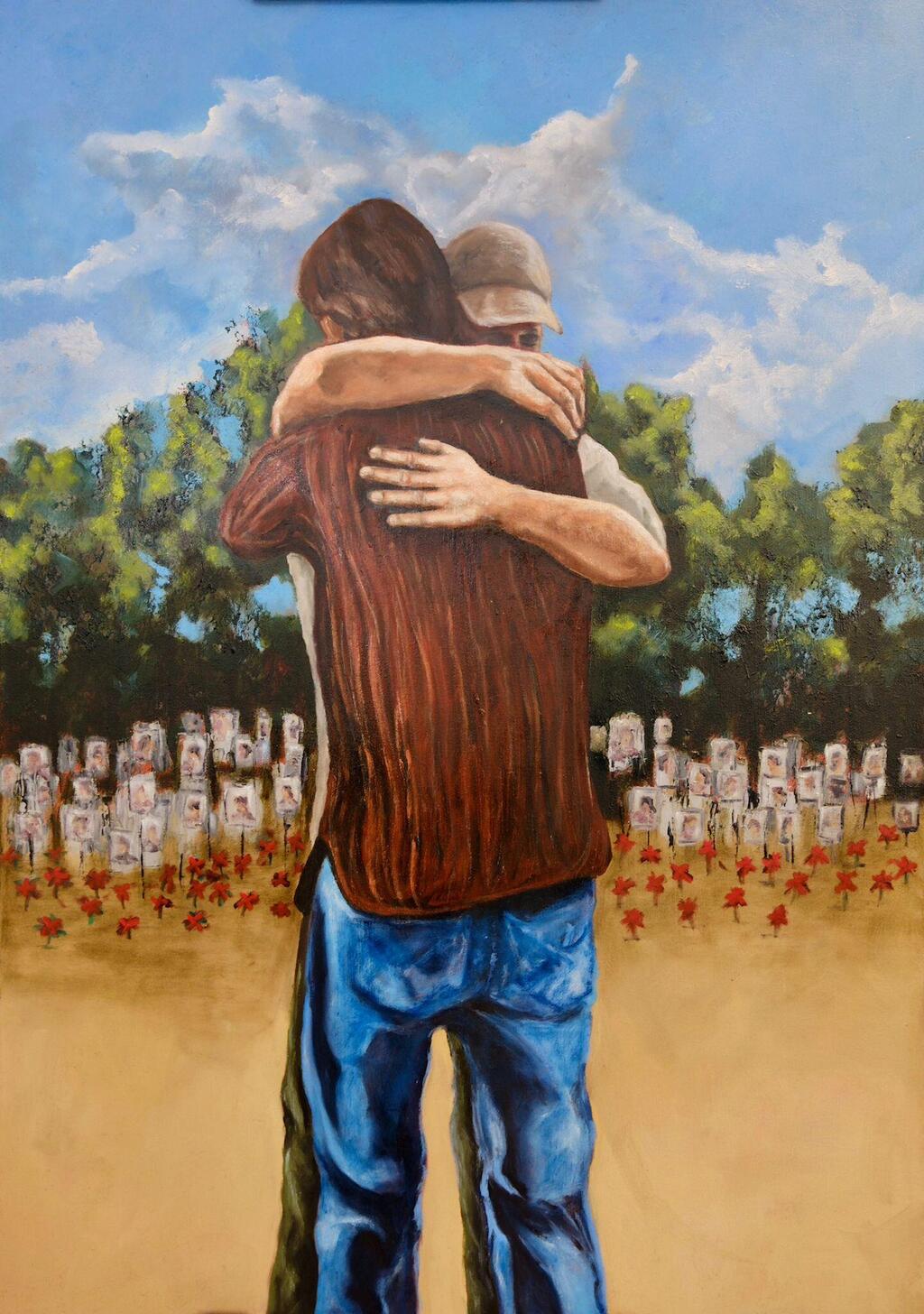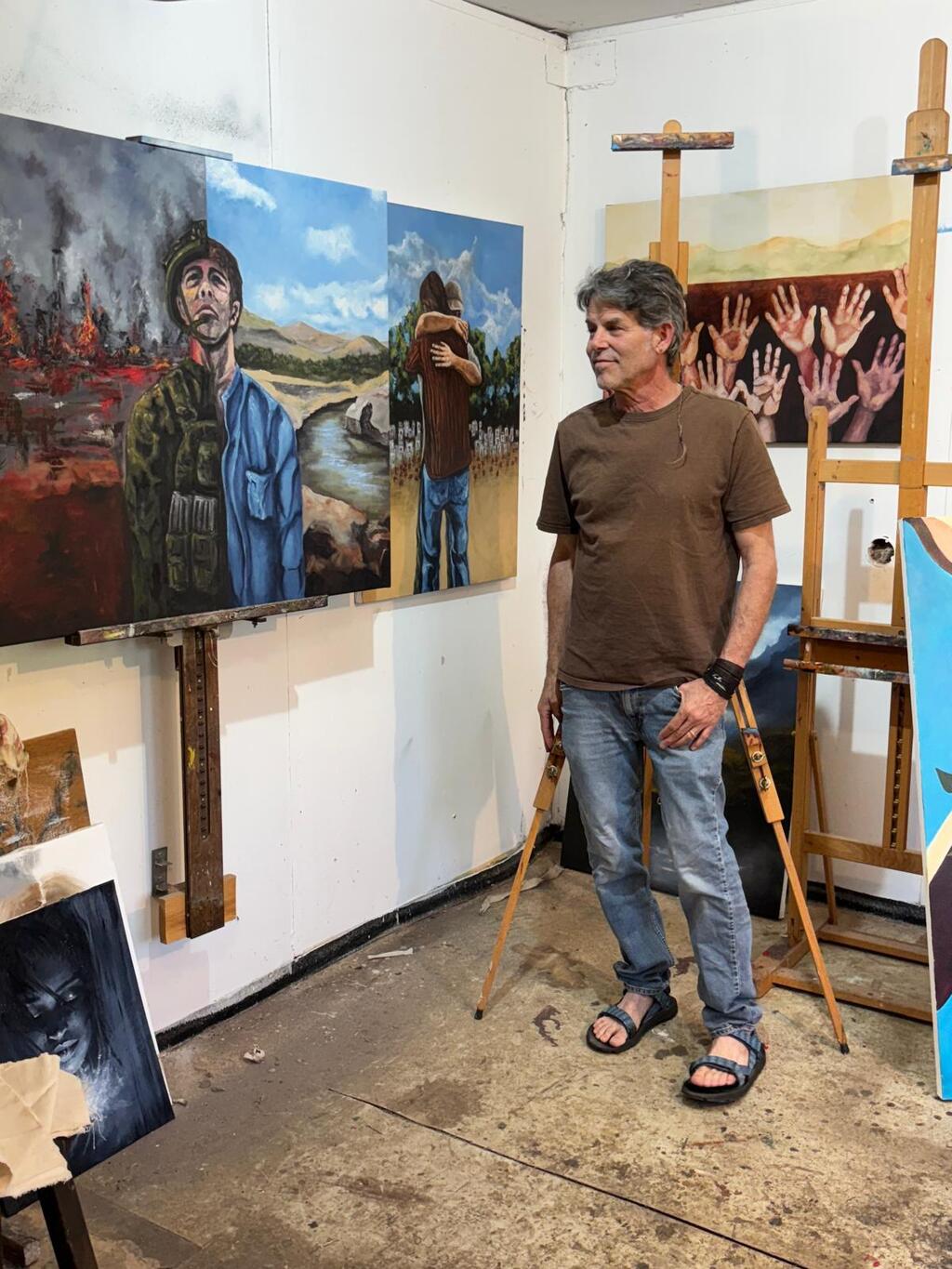On the left side of the oversized canvas, an ash-gray sky bleeds into the burning reds and oranges of fire. The right side glows with hues of blue skies, desert sand, rolling hills, and water. And in the middle stands a figure, half soldier and half civilian. His right arm is wrapped in an army uniform, and a helmet rests on half his head, while his left arm wears a blue civilian jacket.
“This is our life in Israel—split,” said multidisciplinary artist Marc Provisor, whose work explores the intersections of trauma, resilience, and the human condition.
5 View gallery
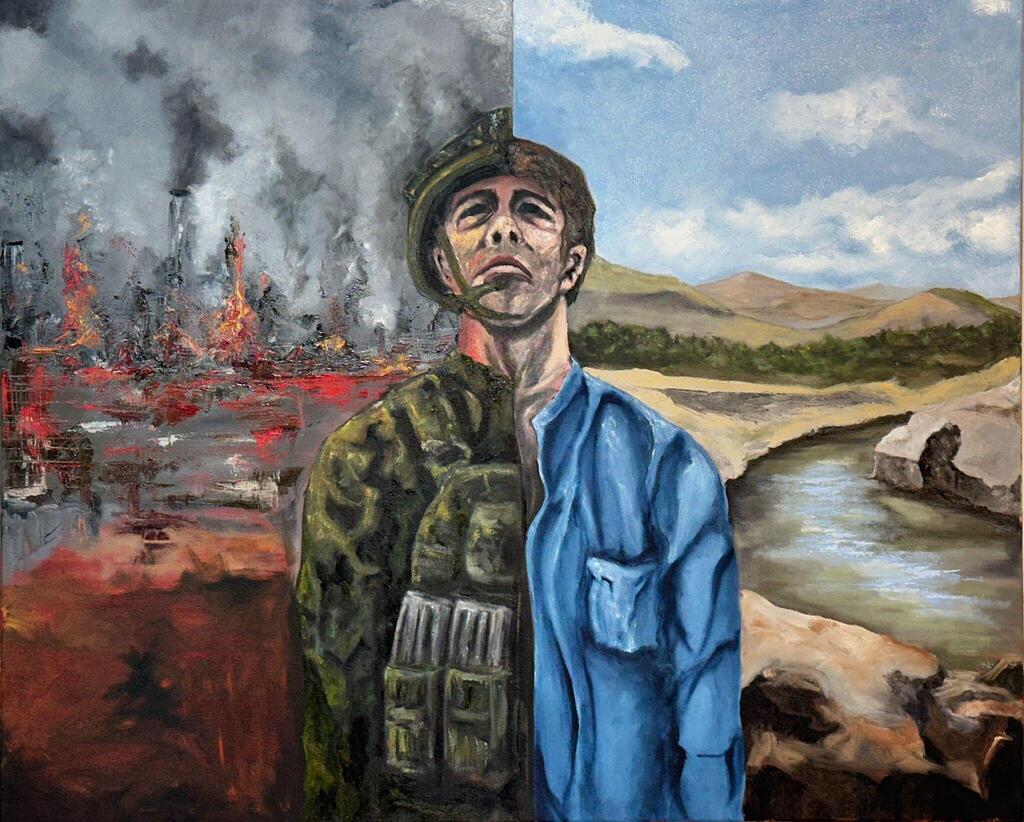

"Between Holiness and the Mundane," a painting by Marc Provisor
(Photo: Maayan Hoffman/The Media Line)
The painting—one in a series he has completed since the October 7 massacre—is titled “Between Holiness and the Mundane.” It’s the phrase Jews recite when transitioning from Shabbat to the weekday.
“Our soldiers are split between war and peace,” Provisor told The Media Line in an interview from his studio in the West Bank community of Shiloh. “They are expected to leave combat, go home, go back. I remember what it is like from my time serving in Lebanon or being the security chief during the Second Intifada. You’d leave an attack and go home and have to act like everything is OK.”
Provisor is well-known in the Jewish world. He served as the director of security projects for the One Israel Fund from 2008 until recently, when he passed the baton to his son. In the art world, he is known as a painter. He maintains two studios—one in Shiloh and a second in the heart of Manhattan—where he creates emotionally charged pieces that fuse his military and counterterrorism experiences with bold brushstrokes and color.
His latest works are especially powerful, reliving the horrors of the Hamas massacre and capturing the ongoing challenge of securing Israel’s northern and southern borders.
In one painting hanging on the wall of his Shiloh studio, a man and his son embrace in the foreground. Behind them, the sky is a healthy, vibrant blue, scattered with clouds and framed by lush trees. But on the ground are tiny red flowers and small placards. Each placard bears a face—tributes to the victims murdered at the Nova music festival.
On October 7, 2023, Provisor’s son Yochai was at that festival. Unlike hundreds of his fellow festivalgoers, he managed to make it home alive.
Leaning against the wall is another piece Provisor calls “Flanders Fields, Israel Version,” modeled after the famous World War I rondeau by Canadian physician Lt. Col. John McCrae.
“I only named it after I painted it,” Provisor said. “I used the red anemones but made them into the map of Israel. Gaza is in the background, burning.”
5 View gallery
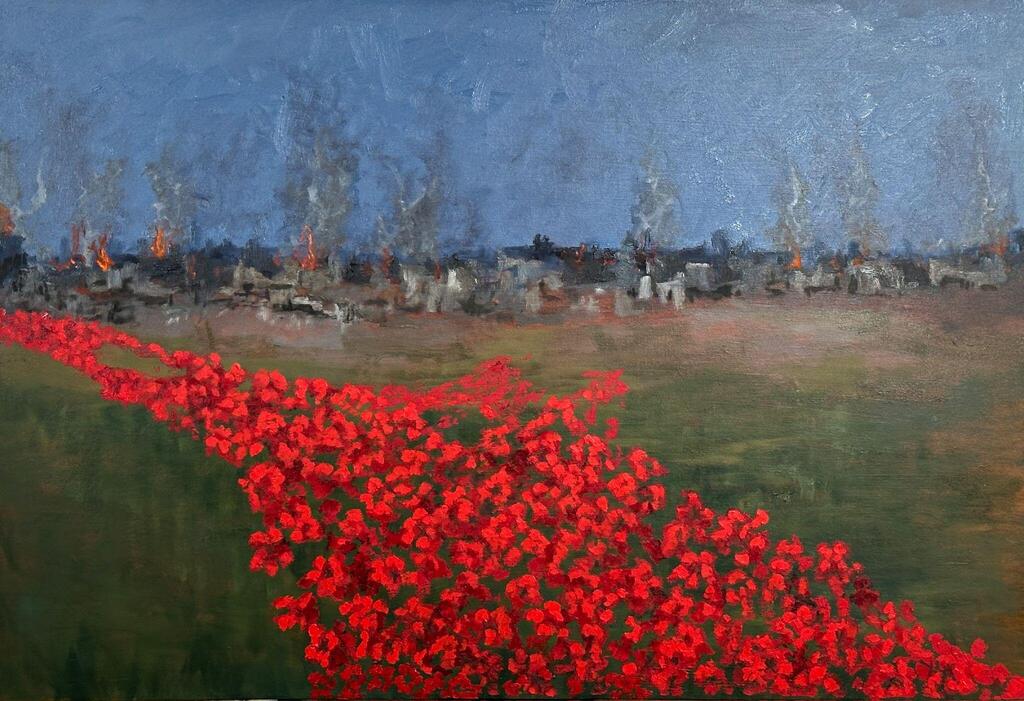

“Flanders Fields, Israel Version,” a painting by Marc Provisor
(Photo: Maayan Hoffman/The Media Line)
For a couple of months after the massacre, Provisor said he couldn’t paint.
On the morning of October 7, 2023, he headed south to rescue his children. Afterwards, he returned to the area for several days in a row to support the rescue and security efforts. He also traveled north to the peripheral communities, where regular Hezbollah attacks led residents to abandon their homes.
“I would try to come into the studio. But seeing the stuff down there. ... This is like my third war in this country, but it was never, never like this. Eventually, I just had to paint,” Provisor recalled.
He created the first two paintings in the series the week after the massacre. One of them features a young woman with the reddest hair, like fire, sitting on the floor of a southern kibbutz. Behind her, homes are ablaze, and across the canvas are scattered small black exes, representing the people murdered that day.
“I had to get this stuff out of my head. It was too much,” Provisor said. “I painted them for me, but I do sell them.”
Provisor began painting in 1983 while serving as a soldier in Lebanon. One day, on his way home from a mission, he and his paratrooper unit were caught in a horrific ambush that blew the windows off their bus and killed many people.
“It was a turning point for me,” Provisor said. “My neighbor, who was an artist and working at Graphos art supply store, gave me a watercolor pad and some watercolors, and I sat in my apartment and I created. I did not have any training or anything, but it felt good. Every time I came back from Lebanon, I would make a painting.”
5 View gallery
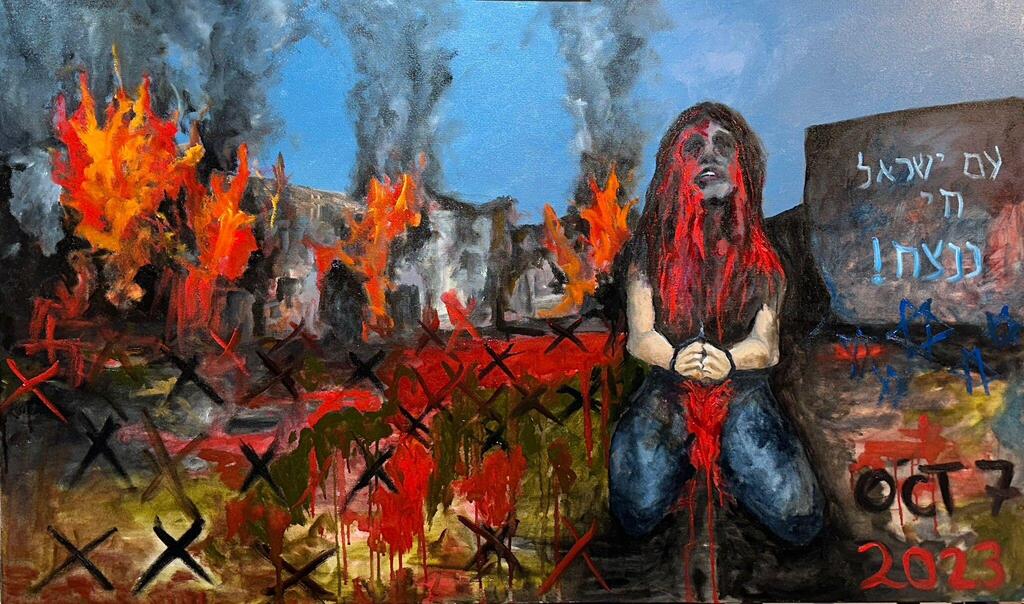

One of the first paintings completed by Marc Provisor following the October 7 attacks
(Photo: Maayan Hoffman/The Media Line)
After finishing his army service, Provisor traveled and eventually landed in New York City, where he attended the School of Visual Arts. There, he was offered a loft studio and began working professionally. But that didn’t last long. When the Iraq War started, Provisor dropped everything to return to Israel. He soon became the security director of Shiloh, a settlement in the West Bank.
He was offered the job, which was supposed to be only a few hours a day, in exchange for a free studio. But when the Second Intifada broke out, everything changed.
Provisor, a father of four grown children, recalled experiencing the daily shootings, the bodies, the death. He had once loved painting landscapes and beauty, but everything that came out of him turned dark.
“All I could see was red and black,” he said. “I could not find the calm that painting had given me.”
So he stopped—cold turkey—in 2002. In 2008, he began working for the One Israel Fund, an organization that supports Jewish communities in the West Bank, while also doing some security consulting.
Then, in 2018, he started reliving some of the security incidents in his mind. He spoke to a psychiatrist and friends, and eventually found that the solution was to pick up the paintbrush again.
“I started working at building up my inventory, selling here and there,” he said. “I wanted to get back to being a full-time artist, and my plan was to do so in mid-October 2023.”
After the war broke out, Provisor’s transition took more than a year to happen.
Ronen Berger, a senior art and nature therapist, supervisor, and lecturer based in Israel, told The Media Line that using art as a form of therapy is common.
“When we create any form of art, we start with nothing. Face an empty piece of paper or a piano with no music, and we search for how to fill up this empty space with ourselves. So we go through a process from emptiness, from void, from loss, from depression, from lack of energy, to finding energy, finding power, to fill up the space,” Berger, who also serves as head of Ono Academic College’s Play Therapy Program and leads the children’s resilience programs at the Israel Community Stress Prevention Center, said. “This connects us to our strength, to optimism and hope.”
Get the Ynetnews app on your smartphone: Google Play: https://bit.ly/4eJ37pE | Apple App Store: https://bit.ly/3ZL7iNv
He explained that many people find it easier to express themselves not with words, but through physical actions such as music and art.
“Many times, in horrific cases like October 7, we do not have words, so we need to find other ways, another language to express ourselves and to communicate with others,” he said. He added that group art experiences, such as drama, can allow people experiencing trauma symptoms to work together, ease their loneliness, and create a sense of connection that helps them cope.
“For some people, color and form are the way that they speak best,” he added.
Provisor often uses deep reds and blacks—even his landscapes carry a certain heaviness. But he said that painting has helped him feel better.
“Even today, I still have a lot of rage about what is going on, but I am able to express my truth through art rather than words,” Provisor said.
He noted that many people involved in counterterrorism or terror prevention also turn to art. While some do so for therapeutic reasons, others are simply “some of the most creative people you will ever meet. They have to think out of the box to achieve their goals.”
“Using the right brain and the left brain lets the creative juices flow,” he said.


